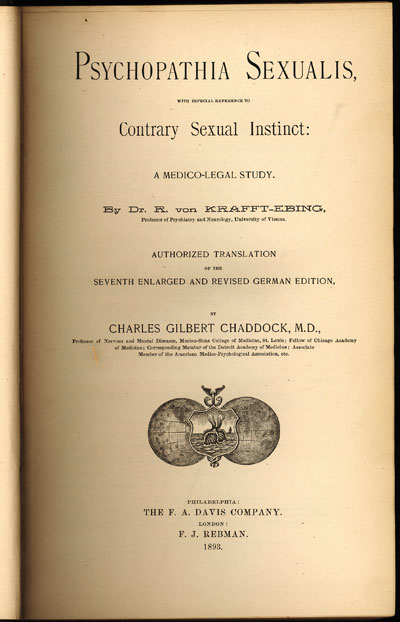Difference between revisions of "Wilson Collection: “Inverts” and “Alienists”"
("Inverts" and "Alienists") |
|||
| (8 intermediate revisions by one other user not shown) | |||
| Line 1: | Line 1: | ||
[[File:Kraftebbing.jpg]] | [[File:Kraftebbing.jpg]] | ||
| − | (Title page of Dr. Richard von Krafft-Ebbing’s influential book, | + | ''(Title page of Dr. Richard von Krafft-Ebbing’s influential book, |
| − | Psychopathia Sexualis, 1893 edition) | + | Psychopathia Sexualis, 1893 edition)'' |
| − | + | '''“Inverts” and “Alienists”''' | |
| − | + | Late in the century, physicians and psychiatrists (known as “alienists”) proclaimed themselves experts on homosexuality.<ref>Jonathan Ned Katz, ''Gay/Lesbian Almanac: A New Documentary: In Which Is Contained…'' (New York: Harper & Row, Publishers, 1983), 245.</ref> To them it was a disease to be cured. Their prescriptions ranged from cold sitz baths (1884) to castration (1893).<ref>Jonathan Katz, ''Gay American History: Lesbians and Gay Men in the U.S.A.'' (New York: Thomas Y. Crowell, 1976), 134.</ref><ref>Katz, ''Gay American'', 136.</ref> | |
| − | + | Doctors called homosexuality “sexual inversion,” alleging that same-sex sexual feelings contradicted anatomical sex.<ref>Katz, ''Almanac'', 147.</ref><ref>Rictor Norton, ''The Myth of the Modern Homosexual: Queer History and the Search for Cultural Unity'' (Washington: Cassell, 1997), 69.</ref> (“Invert” was a common medical term for a homosexual.<ref>Katz, ''Almanac'', 144.</ref>) | |
| − | Doctors called homosexuality “sexual inversion,” alleging that same-sex sexual feelings contradicted anatomical sex. | + | |
| − | A leading figure was Viennese psychiatrist Richard von Krafft-Ebing who promoted a degeneracy theory of homosexuality. | + | A leading figure was Viennese psychiatrist Richard von Krafft-Ebing who promoted a degeneracy theory of homosexuality.<ref>Neil Miller, ''Out of the Past: Gay and Lesbian History from 1869 to the Present'', revised and updated (New York: Alyson Books, 2006), 16.</ref> About him, homosexual-rights pioneer John Addington Symonds stated, “The ignorance of men like...Krafft-Ebing...is incalculable, and is only equalled to their presumption.”<ref>Norton, 70.</ref> |
| − | References | + | |
| − | + | ==''References''== | |
| − | + | <references/> | |
| − | + | ||
| − | + | ||
| − | + | ||
| − | + | ==''To return to "Exhibit contents" links, click:''== | |
| − | + | ==[[Rich Wilson: Aspects of Queer Existence in 19th-Century America]]== | |
| − | + | ||
| + | ==''See also:''== | ||
| + | |||
| + | ==[[Timeline: Treatment of LGBT People by Doctors and Psychologists]]== | ||
| + | |||
| + | ==[[Medical Times: "Aberrations of the Sexual Instinct," February 9, 1867]]== | ||
| + | |||
| + | ==[[Holder's "A Peculiar Sexual Perversion", 1899]]== | ||
| + | |||
| + | __NOTOC__ | ||
Latest revision as of 20:08, 27 November 2012
(Title page of Dr. Richard von Krafft-Ebbing’s influential book, Psychopathia Sexualis, 1893 edition)
“Inverts” and “Alienists”
Late in the century, physicians and psychiatrists (known as “alienists”) proclaimed themselves experts on homosexuality.[1] To them it was a disease to be cured. Their prescriptions ranged from cold sitz baths (1884) to castration (1893).[2][3]
Doctors called homosexuality “sexual inversion,” alleging that same-sex sexual feelings contradicted anatomical sex.[4][5] (“Invert” was a common medical term for a homosexual.[6])
A leading figure was Viennese psychiatrist Richard von Krafft-Ebing who promoted a degeneracy theory of homosexuality.[7] About him, homosexual-rights pioneer John Addington Symonds stated, “The ignorance of men like...Krafft-Ebing...is incalculable, and is only equalled to their presumption.”[8]
References
- ↑ Jonathan Ned Katz, Gay/Lesbian Almanac: A New Documentary: In Which Is Contained… (New York: Harper & Row, Publishers, 1983), 245.
- ↑ Jonathan Katz, Gay American History: Lesbians and Gay Men in the U.S.A. (New York: Thomas Y. Crowell, 1976), 134.
- ↑ Katz, Gay American, 136.
- ↑ Katz, Almanac, 147.
- ↑ Rictor Norton, The Myth of the Modern Homosexual: Queer History and the Search for Cultural Unity (Washington: Cassell, 1997), 69.
- ↑ Katz, Almanac, 144.
- ↑ Neil Miller, Out of the Past: Gay and Lesbian History from 1869 to the Present, revised and updated (New York: Alyson Books, 2006), 16.
- ↑ Norton, 70.
